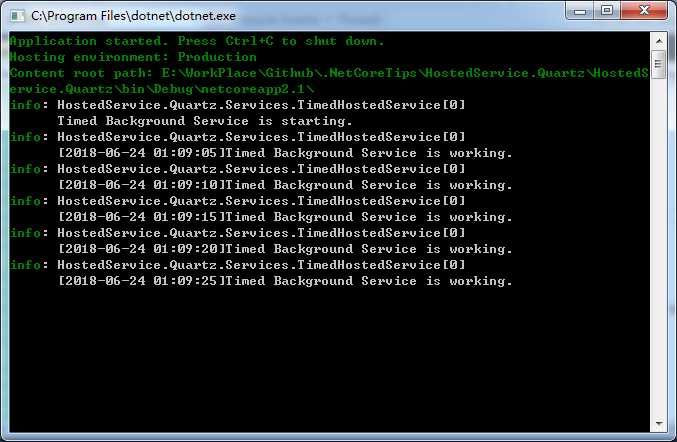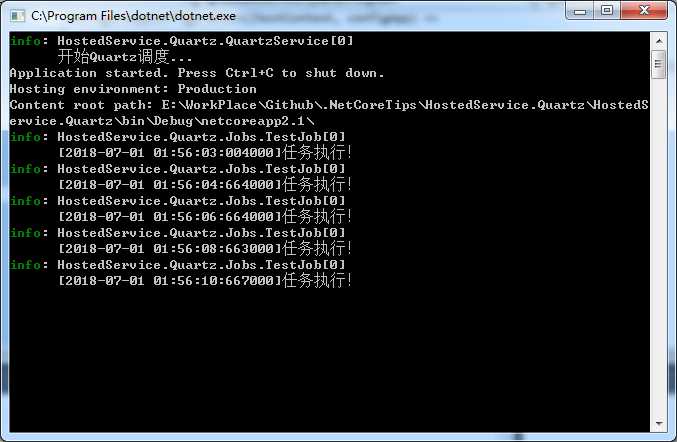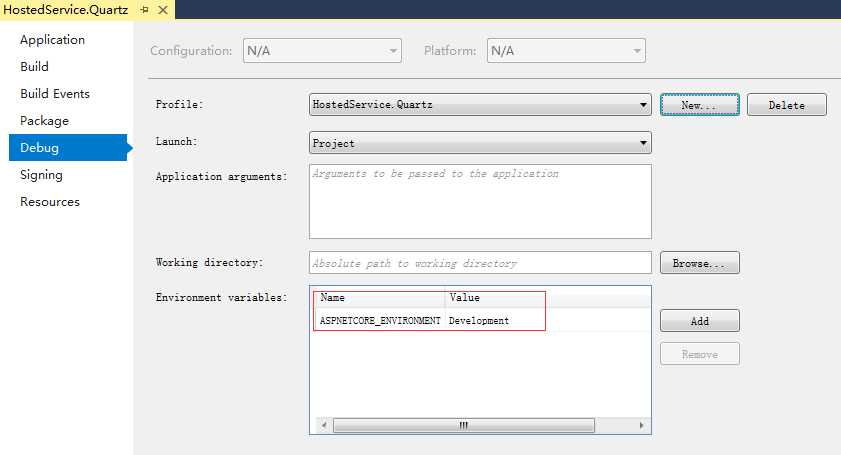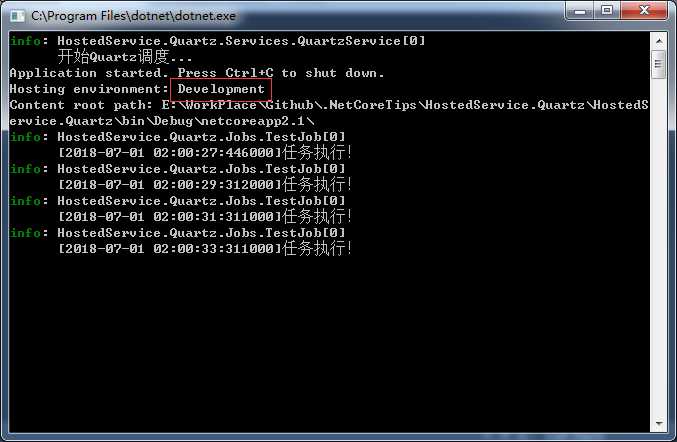.netcore 使用Quartz定时任务
Posted DinAction
tags:
篇首语:本文由小常识网(cha138.com)小编为大家整理,主要介绍了.netcore 使用Quartz定时任务相关的知识,希望对你有一定的参考价值。
这是一个使用 .NET Core 和 Quartz.NET 实现定时任务的完整示例。首先确保已经安装了 .NET Core SDK。接下来按照以下步骤创建一个新的控制台应用程序并设置定时任务:
-
创建一个新的 .NET Core 控制台应用程序:
dotnet new console -n QuartzDemo cd QuartzDemo -
通过 NuGet 添加 Quartz.NET 包:
dotnet add package Quartz --version 3.3.3 -
打开 Program.cs 文件并替换其内容:
using System; using System.Threading.Tasks; using Quartz; using Quartz.Impl; namespace QuartzDemo public class HelloWorldJob : IJob public Task Execute(IJobExecutionContext context) Console.WriteLine("Hello, world! " + DateTime.Now); return Task.CompletedTask; class Program static async Task Main(string[] args) // 创建调度器 StdSchedulerFactory factory = new StdSchedulerFactory(); IScheduler scheduler = await factory.GetScheduler(); // 启动调度器 await scheduler.Start(); // 创建一个作业 IJobDetail job = JobBuilder.Create<HelloWorldJob>() .WithIdentity("helloWorldJob", "group1") .Build(); // 创建一个触发器 ITrigger trigger = TriggerBuilder.Create() .WithIdentity("helloWorldTrigger", "group1") .StartNow() .WithSimpleSchedule(x => x .WithIntervalInSeconds(5) .RepeatForever()) .Build(); // 将作业和触发器添加到调度器 await scheduler.ScheduleJob(job, trigger); // 等待用户按键以关闭 Console.WriteLine("Press any key to close the application..."); Console.ReadKey(); // 关闭调度器 await scheduler.Shutdown();该示例创建了一个名为 HelloWorldJob 的作业,每隔 5 秒执行一次。作业的内容仅输出当前时间的 Hello, world! 消息。
-
运行应用程序:
dotnet run
-
在控制台中,你将看到每隔 5 秒输出一次 "Hello, world!" 以及当前时间。
通过以上步骤,你已成功创建了一个使用 .NET Core 和 Quartz.NET 实现的定时任务示例。你可以根据需求自定义作业和触发器,实现更复杂的定时任务。
.Net Core小技巧 - Hosted Services + Quartz实现定时任务调度
背景
之前一直有朋友问,.Net Core + Linux环境有没有类似Windows服务的东西。其实是有的,我了解的方法有两种:
#1 创建一个ASP.Net Core的Web项目(如Web API),然后通过添加中间件(Middleware)的方式来启动任务;
#2 创建一个.Net Core的项目,添加Host,Dependency Injection,Configuration等组件,然后通过Main方法或中间件的方式启动服务。
但是,上述两种方法都有点不足,如:
#1 会把Web的生命周期引进来,但实际上,我们并不需要Web的功能,如Controller;
#2 本身是没有问题的,但是对开发者的要求相对高一点点,需要对.Net Core的各个组成部分都有一定的认识,简而言之,门槛有一丢丢高。
.Net Core 2.1推出了一个Generic Host的概念,可以很好的解决上面两种方法的不足:

至于为什么选择Quartz来做调度,我想可能是因为情怀吧,因为之前是用的TopShelf+Quartz,其实Hangfire也不错。
使用Hosted Service
1. 创建一个控制台程序。

2. 添加Host Nuget包。
Install-Package Microsoft.Extensions.Hosting -Version 2.1.0
Install-Package Microsoft.Extensions.Configuration.FileExtensions -Version 2.1.0
Install-Package Microsoft.Extensions.Configuration.Json -Version 2.1.0
Install-Package Microsoft.Extensions.Configuration.EnvironmentVariables -Version 2.1.0
Install-Package Microsoft.Extensions.Configuration.CommandLine -Version 2.1.0
Install-Package Microsoft.Extensions.Logging.Console -Version 2.1.0
Install-Package Microsoft.Extensions.Logging.Debug -Version 2.1.0
3. 添加一个基于Timer的简单Hosted Service(用于简单演示),继承IHostedService。
internal class TimedHostedService : IHostedService, IDisposable { private readonly ILogger _logger; private Timer _timer; public TimedHostedService(ILogger<TimedHostedService> logger) { _logger = logger; } public Task StartAsync(CancellationToken cancellationToken) { _logger.LogInformation("Timed Background Service is starting."); _timer = new Timer(DoWork, null, TimeSpan.Zero, TimeSpan.FromSeconds(5)); return Task.CompletedTask; } private void DoWork(object state) { _logger.LogInformation(string.Format("[{0:yyyy-MM-dd hh:mm:ss}]Timed Background Service is working.", DateTime.Now)); } public Task StopAsync(CancellationToken cancellationToken) { _logger.LogInformation("Timed Background Service is stopping."); _timer?.Change(Timeout.Infinite, 0); return Task.CompletedTask; } public void Dispose() { _timer?.Dispose(); } }
4. Main函数中添加Host的相关代码。
var host = new HostBuilder() .ConfigureHostConfiguration(configHost => { configHost.SetBasePath(Directory.GetCurrentDirectory());
//configHost.AddJsonFile("hostsettings.json", true, true); configHost.AddEnvironmentVariables("ASPNETCORE_"); //configHost.AddCommandLine(args); }) .ConfigureAppConfiguration((hostContext, configApp) => { configApp.AddJsonFile("appsettings.json", true); configApp.AddJsonFile($"appsettings.{hostContext.HostingEnvironment.EnvironmentName}.json", true); configApp.AddEnvironmentVariables(); //configApp.AddCommandLine(args); }) .ConfigureServices((hostContext, services) => { services.AddLogging(); services.AddHostedService<TimedHostedService>(); }) .ConfigureLogging((hostContext, configLogging) => { configLogging.AddConsole(); if (hostContext.HostingEnvironment.EnvironmentName == EnvironmentName.Development) { configLogging.AddDebug(); } }) .UseConsoleLifetime() .Build(); host.Run();
5. 查看结果

6. 代码解析
a. Host配置
.ConfigureHostConfiguration(configHost =>
{
//配置根目录
configHost.SetBasePath(Directory.GetCurrentDirectory());
//读取host的配置json,和appsetting类似,暂不需要先注释掉,可根据需要开启
//configHost.AddJsonFile("hostsettings.json", true, true);
//读取环境变量,Asp.Net core默认的环境变量是以ASPNETCORE_作为前缀的,这里也采用此前缀以保持一致
configHost.AddEnvironmentVariables("ASPNETCORE_");
//可以在启动host的时候之前可传入参数,暂不需要先注释掉,可根据需要开启
//configHost.AddCommandLine(args);
})
b. App配置
.ConfigureAppConfiguration((hostContext, configApp) =>
{
//读取应用的配置json
configApp.AddJsonFile("appsettings.json", true);
//读取应用特定环境下的配置json
configApp.AddJsonFile($"appsettings.{hostContext.HostingEnvironment.EnvironmentName}.json", true);
//读取环境变量
configApp.AddEnvironmentVariables();
//可以在启动host的时候之前可传入参数,暂不需要先注释掉,可根据需要开启
//configApp.AddCommandLine(args);
})
c. 配置服务及依赖注入注册,注:没有Middleware的配置了。
.ConfigureServices((hostContext, services) =>
{
//添加日志Service
services.AddLogging();
//添加Timer Hosted Service
services.AddHostedService<TimedHostedService>();
})
d. 日志配置
.ConfigureLogging((hostContext, configLogging) =>
{
//输出控制台日志
configLogging.AddConsole();
//开发环境输出Debug日志
if (hostContext.HostingEnvironment.EnvironmentName == EnvironmentName.Development)
{
configLogging.AddDebug();
}
})
e. 使用控制台生命周期
.UseConsoleLifetime() //使用Ctrl + C退出
其它详细的可参考:https://docs.microsoft.com/en-us/aspnet/core/fundamentals/host/generic-host?view=aspnetcore-2.1
使用Quartz
1. 添加Host Nuget包。
Install-Package Quartz -Version 3.0.5 Install-Package Quartz.Plugins -Version 3.0.5
2. Quartz配置。
之前Quartz的配置是放在quartz.config里面的,但我更喜欢使用appsettings.json,因此,把配置改成了从appsettings.json。
先建一个QuartzOption的类:
/// <summary> /// 更多设置请参考:https://github.com/quartznet/quartznet/blob/master/src/Quartz/Impl/StdSchedulerFactory.cs /// </summary> public class QuartzOption { public QuartzOption(IConfiguration config) { if (config == null) { throw new ArgumentNullException(nameof(config)); } var section = config.GetSection("quartz"); section.Bind(this); } public Scheduler Scheduler { get; set; } public ThreadPool ThreadPool { get; set; } public Plugin Plugin { get; set; } public NameValueCollection ToProperties() { var properties = new NameValueCollection { ["quartz.scheduler.instanceName"] = Scheduler?.InstanceName, ["quartz.threadPool.type"] = ThreadPool?.Type, ["quartz.threadPool.threadPriority"] = ThreadPool?.ThreadPriority, ["quartz.threadPool.threadCount"] = ThreadPool?.ThreadCount.ToString(), ["quartz.plugin.jobInitializer.type"] = Plugin?.JobInitializer?.Type, ["quartz.plugin.jobInitializer.fileNames"] = Plugin?.JobInitializer?.FileNames }; return properties; } } public class Scheduler { public string InstanceName { get; set; } } public class ThreadPool { public string Type { get; set; } public string ThreadPriority { get; set; } public int ThreadCount { get; set; } } public class Plugin { public JobInitializer JobInitializer { get; set; } } public class JobInitializer { public string Type { get; set; } public string FileNames { get; set; } }
3. 重写JobFactory。
public class JobFactory : IJobFactory { private readonly IServiceProvider _serviceProvider; public JobFactory(IServiceProvider serviceProvider) { _serviceProvider = serviceProvider; } public IJob NewJob(TriggerFiredBundle bundle, IScheduler scheduler) { var job = _serviceProvider.GetService(bundle.JobDetail.JobType) as IJob; return job; } public void ReturnJob(IJob job) { } }
4. 编写Quartz Hosted Service
public class QuartzService : IHostedService { private readonly ILogger _logger; private readonly IScheduler _scheduler; public QuartzService(ILogger<QuartzService> logger, IScheduler scheduler) { _logger = logger; _scheduler = scheduler; } public async Task StartAsync(CancellationToken cancellationToken) { _logger.LogInformation("开始Quartz调度..."); await _scheduler.Start(cancellationToken); } public async Task StopAsync(CancellationToken cancellationToken) { _logger.LogInformation("停止Quartz调度..."); await _scheduler.Shutdown(cancellationToken); } }
5. 准备appsettings.json
{ "quartz": { "scheduler": { "instanceName": "HostedService.Quartz" }, "threadPool": { "type": "Quartz.Simpl.SimpleThreadPool, Quartz", "threadPriority": "Normal", "threadCount": 10 }, "plugin": { "jobInitializer": { "type": "Quartz.Plugin.Xml.XMLSchedulingDataProcessorPlugin, Quartz.Plugins", "fileNames": "quartz_jobs.xml" } } } }
6. 编写一个TestJob
public class TestJob : IJob { private readonly ILogger _logger; public TestJob(ILogger<TestJob> logger) { _logger = logger; } public Task Execute(IJobExecutionContext context) { _logger.LogInformation(string.Format("[{0:yyyy-MM-dd hh:mm:ss:ffffff}]任务执行!", DateTime.Now)); return Task.CompletedTask; } }
7. 准备Quartz的调度文件quartz_jobs.xml
<?xml version="1.0" encoding="UTF-8"?> <job-scheduling-data xmlns="http://quartznet.sourceforge.net/JobSchedulingData" xmlns:xsi="http://www.w3.org/2001/XMLSchema-instance" version="2.0"> <processing-directives> <overwrite-existing-data>true</overwrite-existing-data> </processing-directives> <schedule> <job> <name>TestJob</name> <group>TestGroup</group> <description>测试任务</description> <job-type>HostedService.Quartz.Jobs.TestJob, HostedService.Quartz</job-type> <durable>true</durable> <recover>false</recover> </job> <trigger> <simple> <name>TestTrigger</name> <group>TestGroup</group> <description>测试触发器</description> <job-name>TestJob</job-name> <job-group>TestGroup</job-group> <repeat-count>-1</repeat-count> <repeat-interval>2000</repeat-interval> </simple> </trigger> <!--<trigger> <cron> <name>TestTrigger</name> <group>TestGroup</group> <description>测试触发器</description> <job-name>TestJob</job-name> <job-group>TestGroup</job-group> <cron-expression>0/2 * * * * ?</cron-expression> </cron> </trigger>--> </schedule> </job-scheduling-data>
8. 注册Quartz Hosted Service和TestJob
.ConfigureServices((hostContext, services) => { services.AddLogging(); //services.AddHostedService<TimedHostedService>(); services.AddSingleton<IJobFactory, JobFactory>(); services.AddSingleton(provider => { var option = new QuartzOption(hostContext.Configuration); var sf = new StdSchedulerFactory(option.ToProperties()); var scheduler = sf.GetScheduler().Result; scheduler.JobFactory = provider.GetService<IJobFactory>(); return scheduler; }); services.AddHostedService<QuartzService>(); services.AddSingleton<TestJob, TestJob>(); })
9. 查看结果

10. 补充说明。
Generic Service默认的环境是Production,如果想使用Development环境,可以在项目属性的Debug页签中添加环境变量来实现。


源码地址
https://github.com/ErikXu/.NetCoreTips/tree/master/HostedService.Quartz
便捷使用
https://www.nuget.org/packages/Quartz.HostedService/
https://github.com/ErikXu/Quartz.HostedService
以上是关于.netcore 使用Quartz定时任务的主要内容,如果未能解决你的问题,请参考以下文章